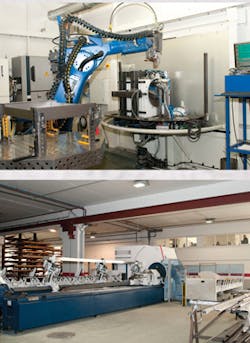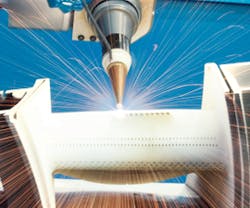Fiber laser drilling for aerospace applications
Study of real-world hole drilling reveals startling results
by Peter Thompson and Mark Barry
Fiber lasers have caught the attention of industrial laser users in a wide range of industries. For a number of welding, marking, and cutting applications, the use of fiber lasers has become the standard. Remarkably, this has happened in a very short time. One area that has remained elusive is the drilling of effusion cooling holes for turbine engine components. This article will explore the reasons for this and more importantly present some of the latest findings that are changing the minds of users of Nd:YAG lasers for this complicated process.
The Nd:YAG drilling process
Nd:YAG laser drilling has made it possible to machine both very small and precise holes, at normal to extreme angles to the surface, in a variety of shapes and orientations and in a wide variety of materials, including difficult-to-machine aerospace alloys. Prima Power Laserdyne, part of Prima Power North America Inc., for example, has installed over 750 systems dedicated to aerospace manufacturing worldwide. A high power (200 to 400 W average power) pulsed Nd:YAG laser is normally used. Processing is accomplished through either percussion drilling (FIGURE 1) or trepanning. In the laser drilling process, high power density is accomplished with a focused spot size of 0.05 mm to 0.75 mm.
Percussion drilling is described as delivering one or more pulses from the laser while the laser beam and part are stationary. More than one pulse may be required depending on the hole depth. A variation of percussion drilling is drill-on-the-fly where pulses are delivered to the part by a stationary laser while the part is rotated. Hole placement is a function of rotational speed and laser pulse frequency. If multiple pulses are required, software is available, such as CylPerf software developed by Laserdyne, which is utilized to synchronize the movement of the part to the laser pulses, ensuring that the multiple pulses are delivered to the exact location required. By changing the laser pulse energy, pulse frequency or lens focal length, the characteristics of the drilled hole size and taper can be adjusted to meet the design requirements of the hole.
Trepanning is another process for drilling holes. The part is held stationary and the laser beam is moved to create a hole or feature by cutting the shape. The term "drilling” is generally used for both percussion and trepanned features. The advent of extremely accurate and repeatable laser positioning systems allows for unique and tight tolerance trepanned features.
Average power is determined by the pulse frequency and pulse energies selected. Power is limited by the duty cycle at which a laser can operate without degradation of performance. Percussion drilling is accomplished using average power from <100 W to 400 W. Pulse length is selected to optimize the quality of the hole. Shorter pulse lengths may limit the maximum energy achievable in a single pulse. Typical drilling pulse lengths range from 0.5 to 2 ms.
Pulse energy is the characteristic that separates drilling lasers from lasers capable of other processes. Higher pulse energy may provide faster drilling rates, but this can also be detrimental to the hole quality. The pulse energy required is most often determined by experimentation and is a result of material thickness, composition, and hole diameter required.
Focusing lenses will determine the spot size for a given laser setup. In percussion drilling the spot size correlates to the desired hole diameter to be drilled. The focused spot size is nearly equal to the hole size in thinner materials (i.e., <0.5 mm). As metal thickness increases, the range of hole diameters that can be percussion-drilled decreases. This is where trepanning (FIGURE 2) becomes important.
Laser hole drilling technology has been employed for almost 45 years on turbine engine components used in aircraft and land (power generation) applications. Automotive engineers, filtration designers, and medical manufacturers are a few of the other users of laser technology that would not be able to manufacture their parts without the laser drilling process.
Initial study results of fiber laser drilling
Ytterbium (Yb) fiber lasers are the most common type of fiber laser used for material processing. They were first developed as a continuous wave (CW) laser. Pulsing was added, but peak power remained the same as CW average power. While this proved effective for cutting and welding, it limited the effectiveness of the laser for hole drilling. The Nd:YAG lasers commonly used for hole drilling have peak powers to 50 kW, and many applications use peak power of 20 to 35 kW pulses.
Renewed interest in the use of Yb fiber lasers came about after the installation of a Laserdyne 795 system in the IPG Photonics applications lab in Oxford, MA. It was demonstrated that with a 20 kW CW fiber laser, holes could be percussion-drilled and trepanned with surprisingly good results. This early work led to the installation of a 15 kW CW Yb fiber laser at the Laserdyne Champlin, MN, applications lab for a period of concentrated study on hole drilling.
The purpose of this study was to gain additional data on practical real-world hole drilling and to identify the size of laser that was going to be required for the next step. As attractive as the results have been to date, there was a significant problem with the implementation of Yb fiber lasers for hole drilling — laser cost. For all the promise of the fiber laser, there was a 5× penalty in laser cost. It was thought that this could not be justified in manufacturing operations.
An alternative was proposed. A quasi-continuous wave (QCW) laser could be built with approximately the same selling price as an Nd:YAG laser. The size range of the QCW laser needed to be established through a round of testing.
Study conclusions
At the end of this phase of the study, the following conclusions were drawn:
- While hole drilling can be accomplished with fiber laser parameters very closely resembling the parameters used on a Nd:YAG laser, a wider range of parameters made it possible to increase throughput and/or hole quality.
- The increase in beam quality and ultimately in power density and reduction of spot size with the fiber laser had a dramatic effect on metallurgical results.
- Drilling of materials with thermal barrier coating (TBC) showed marked improvement in terms of delamination.
- Trepanning holes rather than percussion drilling became more "affordable”. Trepan holes have always resulted in better geometry and metallurgy than percussion-drilled holes. However, the increase in quality comes at the expense of productivity since it is generally acknowledged that percussion drilling can produce 1 hole/s while trepanning the same hole will take 3 s, and drill-on-the-fly techniques can produce the same quality at a rate of 3 holes/s.
- There is the possibility that very nonconventional drilling parameters could be employed and would produce acceptable results. As an example, a 0.5 mm diameter hole was drilled at 30° to the surface through 1.45-mm-thick TBC coated material. Holes were produced in 0.10 s each with a single "long” pulse of 8ms.
- QCW lasers in the 9 to 12 kW range would make effective drillers. In fact, when the results were announced, several companies with large laser drilling requirements conducted further focused studies. These studies led to system orders from companies in the US as well as Europe.
As positive and startling as the results have been there remains a number of questions and some concerns. Chief among them is the ability to control hole size if percussion drilling and drill-on-the-fly techniques are utilized. A full list has been compiled and will be explored in the next round of testing.
A review of the complete report is encouraged for all those who are interested in this subject. Initial study results, including the author’s audio, is available at http://www.primapowerinterface.com/fldp/index.html. The results obtained have led to the purchase of a 12 kW QCW for continued applications studies at Laserdyne’s application lab. These tests are ongoing and will be reported in a similar manner as the first round. ✺
Peter Thompson is director of technology and Mark Barry([email protected]) is VP, sales and marketing, at Prima Power Laserdyne (www.primapower.com).
More Industrial Laser Solutions Current Issue Articles
More Industrial Laser Solutions Archives Issue Articles


